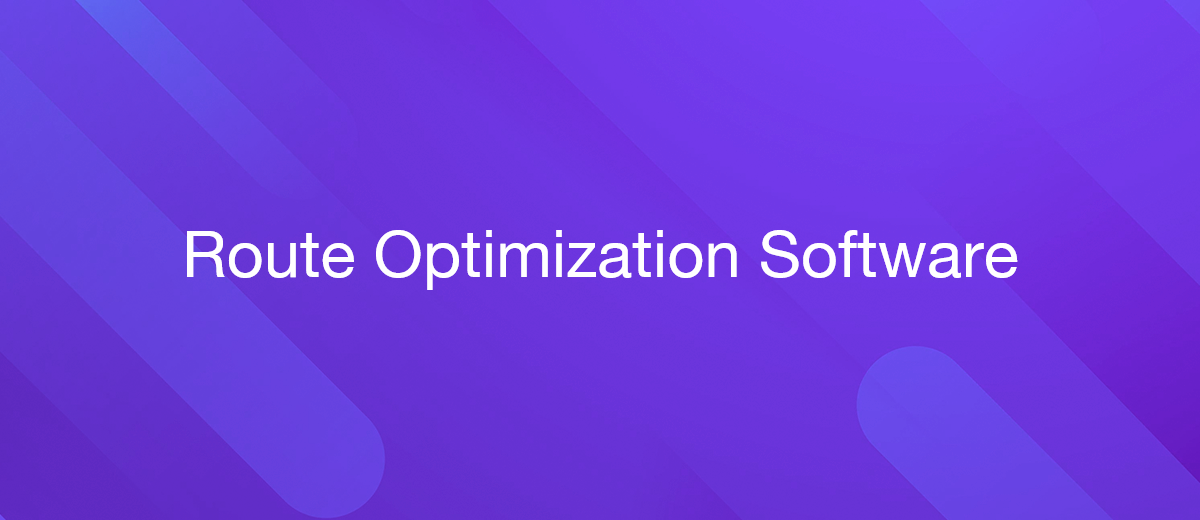The Game Changer in Logistics: Route Optimization Software
Software for route optimization has emerged as a significant game-changer in the ever-evolving logistics landscape. Using cutting-edge algorithms, artificial intelligence, and real-time data, this cutting-edge technology accurately determines the most effective routes for transportation and delivery operations, bringing the sector unprecedented advantages. Software for route optimization is more than just a digital mapping tool; it is also a strategic asset for businesses that want to improve operational efficiency, cut costs, and make customers happier. By taking into account a wide range of variables, such as traffic conditions, vehicle capacities, and delivery windows, it transforms complex logistics challenges into streamlined and manageable processes.
In this blog, we look at how route optimization software came to be, the key technologies that underpin it, and how important it is to modern logistics. Come along with us as we investigate the compelling story of route optimization and its significant impact on the logistics sector.
The Evolution of Route Optimization Software
From simple planning and manual routing tools, route optimization software has significantly evolved. You can download Upper route planner-like tools to better understand route optimization software because the early adaptations principally centered around giving the most limited conceivable course. Nonetheless, the most recent programming considers various factors to give the briefest as well as the most effective course.
The incorporation of real-time data, the integration with other logistical systems, and the utilization of AI and Machine Learning to enhance route predictions and adjustments are some significant advancements. Businesses can now more effectively and proactively manage their logistics thanks to these advancements.
Technologies That Underpin Modern Route Optimization Software

The development of modern route optimization software has been aided by technological advancements. Artificial Intelligence (AI) and Machine Learning (ML), GPS and real-time tracking, big data analytics, and the Internet of Things (IoT) are four technologies that have had a significant impact.
1. Machine learning (ML) and artificial intelligence (AI)
Machine learning (ML) and artificial intelligence (AI) are key components of the optimization process. They make it possible for the software to gain knowledge from previous experiences and continuously increase efficiency. ML algorithms, for instance, are capable of analyzing previous route data to identify patterns, anticipate potential delays, and accordingly recommend the most effective routes. AI, on the other hand, makes it easier to make decisions in real-time, like changing a route in response to bad road conditions.
2. Real-Time Tracking and GPS
The availability of real-time location data has revolutionized route optimization. It enables logistics managers to quickly respond to unforeseen occurrences by monitoring the precise location of vehicles. Customers' delivery experiences are enhanced by real-time tracking transparency.
3. Big Data Analytics
Route optimization software frequently incorporates big data analytics for the purpose of processing and analyzing large amounts of data. This makes it easier to identify relationships, trends, and patterns related to route efficiency. For instance, the software might look at data from hundreds of routes to figure out which ones consistently cause deliveries to be late, allowing businesses to address these problems in advance.
4. Internet of Things (IoT)
By connecting vehicles, devices, and systems in the logistics network, the IoT has the potential to transform route optimization. IoT sensors can gather information about the health of a vehicle, the actions of drivers, fuel consumption, and more. After that, this data can be incorporated into the software for route optimization to enhance decision-making, anticipate maintenance requirements, and enhance overall efficiency.
The power and potential of route optimization software are boosted by the synergistic effect of these technologies. In the logistics sector, we can anticipate even more sophisticated and efficient route optimization solutions as technology advances.
Benefits of Route Optimization Software in Logistics
The logistics industry has benefited greatly from the incorporation of route optimization software, which has resulted in a plethora of advantages that increase customer satisfaction, decrease costs, and improve efficiency. Here are a portion of the key benefits:
- Improved Efficiency. Through the design of the most effective routes by route optimization software, travel time and distance are reduced, allowing businesses to complete more deliveries in the same amount of time. Logistics managers can save a lot of time that was previously spent on manual route planning by using automated route planning.
- Cost Savings. A lot of money can be saved through effective route planning. Businesses can save a lot of money on fuel costs by driving less and spending less time on the road. Also, course enhancement programming can diminish vehicle mileage, bringing down upkeep costs over the long run.
- Improved Customer Satisfaction. In the logistics industry, customer satisfaction is crucial, and route optimization software helps improve it by ensuring timely deliveries. Transparency is provided by real-time tracking, allowing customers to precisely anticipate their delivery. Customer satisfaction and loyalty can be significantly enhanced by this reliability and transparency.
- Sustainability. Route optimization software contributes to sustainability by reducing travel distance and, as a result, fuel consumption. Companies can lower their impact on the environment and better align their operations with the rising global sustainability goals by driving fewer miles.
- Increased Safety for Drivers. Route optimization software can also help keep drivers safe by steering clear of risky routes and ensuring that drivers don't rush to meet tight schedules. In addition, features like weather integration and real-time traffic updates can alert drivers to potential dangers on their routes.
These advantages highlight the route optimization software's transformative potential in the logistics sector. This technology is expected to play an even larger role in determining the logistics industry's future as businesses continue to push for more effective operations and better customer service.
Challenges and Solutions in Implementing Route Optimization Software
While course advancement programming carries critical advantages to strategic activities, its execution isn't without challenges. In any case, understanding these obstacles and planning to overcome them can pave the way for smooth integration and the greatest return on investment. We should check out a portion of the normal difficulties and their answers:
Technical challenges
A few associations might confront specialized difficulties during the underlying phases of programming execution, for example, framework similarity issues, information incorporation challenges, or programming intricacy.


Arrangement: Banding together with a dependable programming supplier that offers strong specialized help can assist with moderating these difficulties. Furthermore, associations can put resources into preparing projects to improve their group's specialized abilities and programming understanding.
Organizational resistance
Change can frequently start obstruction inside an association, and the presentation of course improvement programming is the same. Representatives might be uneasy about new advancements, dreading employment misfortune or expanded intricacy in their jobs.
Arrangement: Clear correspondence about the advantages of the product, consolations about employer stability, and thorough preparation can assist with beating this opposition. Featuring how the product can make errands simpler and more proficient may likewise help with acquiring worker purchases.
Data privacy and security concerns
As course advancement programming depends vigorously on information, worries around information protection and security might emerge. This is particularly relevant given the touchy idea of some coordinated factors information.
Arrangement: Guaranteeing rigid information safety efforts are set up is basic. Associations ought to work with programming suppliers who focus on information encryption, client verification, and other security conventions to safeguard delicate data.
Cost implications
Carrying out new innovations can be a significant speculation, which might be an obstacle for certain associations, especially little to medium-sized organizations.
Arrangement: Cautiously assessing the likely profit from speculation can ease worries about cost. While there's a forthright cost, the drawn-out reserve funds and effectiveness gains can immediately counterbalance this underlying expense.
Beating these difficulties can make way for fruitful course improvement programming execution, opening new degrees of proficiency, cost viability, and consumer loyalty in strategy activities. As innovation keeps on advancing, organizations that can capably explore these obstacles will be strategically set up to lead in the planned operations industry.
Development Aspects of Route Optimization Software
There are a lot of things to think about when developing software for route optimization. The software's scalability, user experience, and adaptability to unique logistical challenges are all influenced by these elements. Let's take a look at the fundamental components that constitute the software's foundation:
- Requirement Analysis. The first step in the development process is to thoroughly comprehend the potential users' logistical requirements. This could be anything from the number of vehicles in the fleet to specific delivery windows and stop times. In order to guarantee that route optimization software has the adaptability necessary to handle complex logistics scenarios in the real world, software developers must take these diverse requirements into consideration.
- Selection and Development of the Algorithm. A sophisticated algorithm that determines the most effective routes is at the heart of software for route optimization. It is very important to choose the right algorithm; the most common ones are the Genetic Algorithm, the Ant Colony Optimization, and the Particle Swarm Optimization. Frequently, the chosen algorithm must be modified or improved to meet particular constraints and requirements.
- Integrating Relevant Technologies. As previously mentioned, modern route optimization software is heavily influenced by technologies like AI, machine learning, GPS, big data analytics, and the Internet of Things. The software's capabilities, including real-time updates, predictive analysis, and effective data handling, can be enhanced by ensuring the seamless integration of these technologies during development.
- Design of the User Interface. A user-friendly interface is essential for making the software accessible to logistics managers and simple to use. During development, an intuitive and responsive interface must be developed. This includes providing comprehensive software support and guidance, easy access to key features, and clear route visualization.
- Testing and Iteration. Route optimization software, like all software, needs to be tested a lot to make sure it works well and is reliable. Stress testing (how it handles large, complex data sets) and usability testing (how user-friendly and intuitive it is) should be part of this. In an iterative development process, the feedback from these tests should be used to refine and enhance the software.
- Scalability. Scalability should be considered when designing the software. Logistics operations become more complex as businesses expand. The software for route optimization ought to be able to deal with this increased complexity without compromising performance.
- Support and Updates. Following the development, it is essential to offer users prompt support and routine software updates in order to keep up with the changing logistical landscape, technological advancements, and user needs.
A route optimization software solution that is robust, user-friendly, flexible, and future-proof can be created by keeping these aspects in mind during development, making it a valuable asset in the logistics industry.
Future Trends and Prospects in Route Optimization Software Development
Route optimization software's prediction capabilities could be further enhanced by advanced AI models. AI models are able to discover hidden patterns and make more accurate predictions by analyzing a large amount of historical data, such as traffic patterns, delivery times, and driver behavior. These advanced prediction capabilities have the potential to improve delivery times, increase overall efficiency, and optimize even more routes.
When dealing with sensitive location and logistical data, ensuring data privacy is essential. Finding some kind of harmony between gathering vital information for enhancement purposes and safeguarding the protection of people and organizations is a huge test. Strong safety efforts and consistency with significant information assurance guidelines will be fundamental.
Conclusion
Software for route optimization has emerged as an essential tool in the rapidly changing logistics landscape. To stay on the same page with the industry market, you can understand delivery logistics app development and how this kind of integration works. It has transformed logistics operations, driving efficiency, cost savings, and improved customer service by utilizing the power of AI, machine learning, GPS, big data analytics, and the Internet of Things.
The potential benefits clearly suggest that this technology is here to stay and will continue to redefine industry norms, despite the difficulties associated with its implementation. The benefits and capabilities of route optimization software are expected to grow even more as it continues to evolve. Businesses that embrace this cutting-edge technology will undoubtedly be at the forefront of the logistics industry as we progress into the digital age.
Routine tasks take a lot of time from employees? Do they burn out, do not have enough working day for the main duties and important things? Do you understand that the only way out of this situation in modern realities is automation? Try Apix-Drive for free and make sure that the online connector in 5 minutes of setting up integration will remove a significant part of the routine from your life and free up time for you and your employees.

